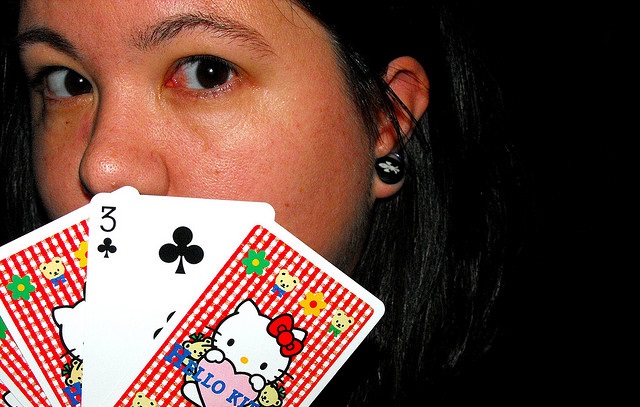Math Concepts: sorting by attribute (card suits), counting up, counting down, standard rank of playing cards (aces low).
Players: two or more, best with four to six.
Equipment: one complete deck of cards (including face cards), or a double deck for more than six players. Provide a card holder for young children.
How to Play
Deal out all the cards, even if some players get more than others. The player to the dealer’s left begins by playing a seven of any suit. If that player does not have a seven, then the play passes left to the first player who does.
After that, on your turn you may lay down another seven or play on the cards that are already down. If you cannot play, say, “Pass.”
Once a seven is played in any suit, the six and the eight of that suit may be played on either side of it, forming the fan. Then the five through ace can go on the six in counting-down order, and the nine through king can go on the eight, counting up. You can arrange these cards to overlap each other so the cards below are visible, or you can square up the stacks so only the top card is seen.

Players do not need to wait for both the six and eight of a suit to be played before they begin building the fan up or down.
The first player to run out of cards wins the game.
If you want to keep score, count the cards remaining in your hand after one player goes out. After everyone has had a turn as dealer, whoever has the lowest total score is the champion.
Variations
In some traditions, play always begins with the seven of diamonds, so whoever has that card goes first.
Domino Tan
The player to the dealer’s left may lead any card, and then all the suits must start with that number (instead of with seven) and build up and down from there.
Fan Tan Trumps
When the dealer gets to the end of the deck and there aren’t enough cards to give every player one more, the last few cards are turned face up and may be played by anyone as needed. The suit of the last card becomes the trump suit, and cards of that suit may be played on any of the fans, with the card they replace going on the trumps fan. In this case, the cards must be laid out in overlapping rows, not stacked up, so everyone can see where the trumps have gone.
For instance, if spades are trump, then a nine of spades could be played on the eight of hearts, which would leave the nine of hearts without a home—so it has to go on the spades fan.
Exceptions: The seven of the trump suit starts its own fan, like any other seven, and the last card dealt (the one that named the trump suit) must also be played to the trumps fan when its turn comes.
Crazy Tan
Deal only seven cards to each player, and set the rest of the deck out as a draw pile. The first player who cannot play must draw one, which he may play if possible. If not, and the next player also cannot play, she must draw two. If neither of those cards will play, and the next player has nothing to play, he must draw three, and so on, each player drawing one more card than the last person. When one of the players is finally able to lay down a card, this resets the draw count back to zero.
In Crazy Tan, players are allowed to lay down a run (playing several cards in a row of the same suit on a single turn). Or they may play parallel cards (cards of the same rank in different suits, all played in the same turn). Or a player may even lay down parallel runs, if the cards happen to work out that way.
History
Fan Tan may also be called Crazy Sevens. Like any folk game, it is played by a variety of rules around the world. If you search for it on the Internet, you may run into an unrelated Chinese gambling game called Fan Tan, which is similar to Roulette.
* * *
 This post is an excerpt from my book Counting & Number Bonds: Math Games for Early Learners, available now at your favorite online book dealer.
This post is an excerpt from my book Counting & Number Bonds: Math Games for Early Learners, available now at your favorite online book dealer.
This blog is reader-supported.
If you’d like to help fund the blog on an on-going basis, then please join me on Patreon for mathy inspiration, tips, and an ever-growing archive of printable activities.
If you liked this post, and want to show your one-time appreciation, the place to do that is PayPal: paypal.me/DeniseGaskinsMath. If you go that route, please include your email address in the notes section, so I can say thank you.
Which I am going to say right now. Thank you!
“Math Game: Fan Tan (Sevens)” copyright © 2015 by Denise Gaskins. Image at the top of the post copyright © Morgan (meddygarnet) via Flicker (CC BY 2.0).

I love this. I’ll be doing this with my son.
I hope you enjoy it! I think it’s a fun game. 🙂